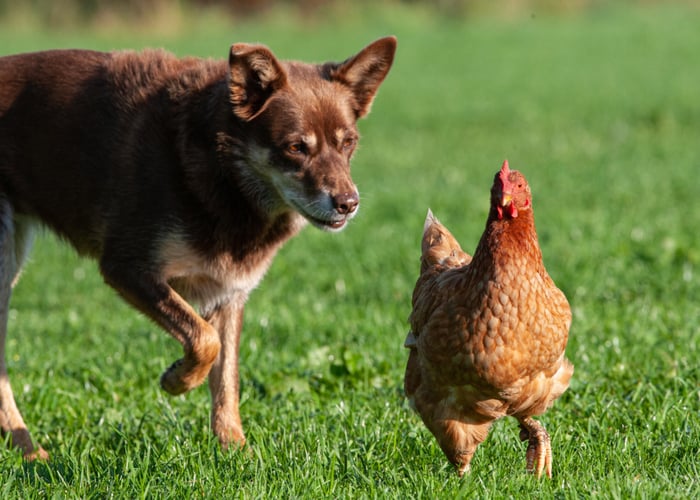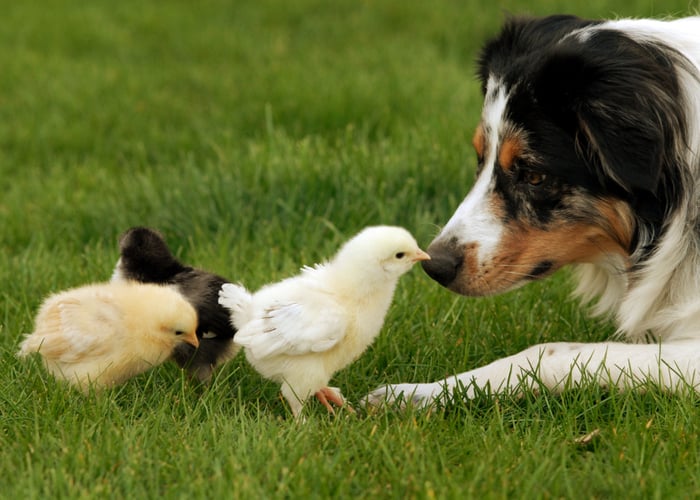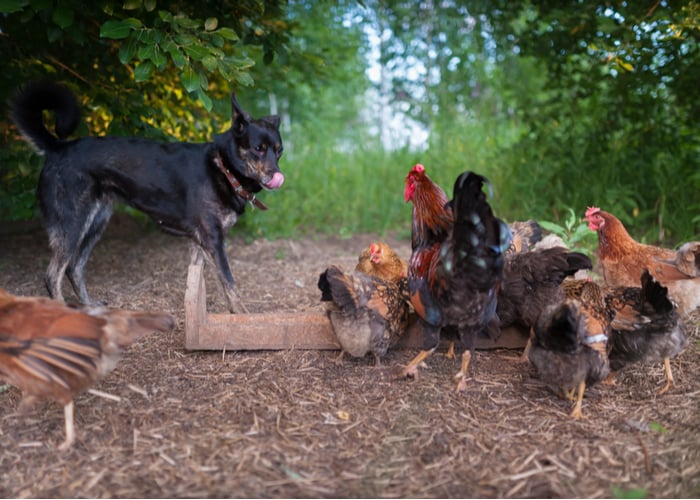Have you ever tried to introduce dogs to your chickens? Or are you planning to do so?
The idea of canines and chickens getting along with each other may sound counterintuitive for a reason.
Dog’s cousins and chickens have a predator-prey relationship in the wild, and some dogs retain their hunting instinct to this day.
So, if you’re having second thoughts, that’s okay.
BUT, it is possible to establish a good relationship between them.
And that’s what we’re going to discuss today.
So, if you want to:
- Discover how to establish a good relationship between your canine and chicken
- Learn how to introduce dogs to your chickens
- And know what to do if your dog tends to kill their feathery siblings
We got your back. We curated a guide that’ll help you succeed in this challenging task.
But before anything, do you wonder why dogs chase chickens?

Why Do Dogs Chase Chickens?
Pet dogs are carnivores, and as we said earlier, the instinct they were bred for remains in their inner self despite hundreds of breed selections.
Most dogs were bred to hunt and chase prey like many terriers, greyhounds, huskies, etc.
But not all dogs who chase after livestock like chicken wants to kill. Sometimes, they want to play and have fun.
It may seem harmless.
However, this act can wreak havoc and make chickens almost break their neck or cause a heart attack.
Imagine the trauma of being chased by a predator more prominent than you.
Isn’t it’s nerve-wracking? Well, that’s what a chicken could feel as it strives to find a safer place.
The stress that it might cause can even alter a chicken’s egg-laying routine.
Things to Consider Before You Introduce Dogs to Your Chickens
Before introducing your canine companion to your chicken, here are some things you need to consider.

Their Space Needs
Dogs and chickens both need a personal space where they will feel safe and secure.
So it is crucial to consider this need before introducing them to each other.
Considering the dog’s size and activity level can help decide how much space to offer to him.
On the other hand, chickens typically require a coop with four square feet of space per chicken and an eight-square-foot run.
The dog should not be permitted to enter this area, so you need to fence it to separate them.
They’re likely to learn to share a space if they grow comfortable with each other.
However, they still need a room for some privacy.
For example, the dog may need to be kept out of the run and given space.
You can either place him within the home or in his dog house in a separate yard area.

The Breed
One crucial thing to remember before introducing dogs to your chickens is that their breed plays a role in their interaction with other livestock.
It means that every chicken and dog breed has a different temperament and behavior.
Some chickens are more docile, curious, and not skittish, and they are the ones who are more likely to get along with dogs.
Docile chicken breeds who can be good friends with dogs:
Silkies
Unlike other hard-feathered breeds, this small bantam breed has gorgeous, silky, fluffy feathers.
It’s smaller than standard chicken size and is typically calm and friendly.
Sussex
Kind and curious Sussexess are docile but confident and friendly. They are easy to handle and love foraging.
Since they’re generally non-aggressive, they can make good friends with their furry siblings.
Buckeyes
Similar to the previous breeds mentioned, Buckeyes are docile, friendly, and calm.
It is a gentle chicken who will not bully others. They appear unafraid of humans, unlike many other breeds.
They also have the habit of greeting you by clustering around your legs.
Australorps
The Australorp is a fantastic addition to any flock.
They are an excellent bird for newbies because they don’t need much special care and are easy to deal with.
Easter Eggers
These sweet, quiet, and curious birds are friendly with animals and even children.
They love getting treats and are a good choice for any family flock.
Dog breeds that are generally more friendly towards chicken
Similar to chickens, breed selection is also essential for dogs.
These canines are the ones who are more friendly toward their feathery siblings.
Collies
The regal Collie is one of the world’s most recognizable and beloved dog breeds.
The full-coated ‘rough’ pup is the most common, but there’s a sleek ‘smooth’ Collie variation too.
This breed is family-friendly and easy to train.
Since they get along with children well, they’re more likely to socialize with other livestock like chickens.
Komondors
The Komondor is a massive Hungarian flock guardian wrapped with profuse white cords from head to tail, making it one of the most distinctive Hungarian breeds in the world.
Kom’s independent and protective nature necessitates an experienced trainer.
However, this breed is highly affectionate to humans and generally trainable.
The Great Pyrenees
These large, white, thickly-coated, and powerful working dogs were developed to keep wolves and other predators away from sheep on icy mountaintops.
Today’s Pyrs are gentle companions and protective guards of house and family and are usually friendly towards other livestock.
Anatolian Shepherds
An Anatolian Shepherd Dog is an ancient lineage of rugged, formidable flock guardians.
These strong avengers are revered as outstanding working guard dogs.
They are protective and territorial but also clever, patient, and very loyal.
Dog breeds that are aggressive towards feathery animals
On the other hand, these breeds take more work to foster friendship with chickens due to their high-prey drive:
Huskies
Sibes are innately friendly and affectionate, with beautiful almond-shaped eyes and unique coat color and pattern.
However, these mischievous fidos are energetic, and they can’t help chasing small animals and feathery siblings.
Greyhounds
The Greyhound, the world’s fastest dog, is a gentle, noble, and sweet-tempered companion with a strong will and independent spirit.
But the downside is it takes time to train them even if they’re adaptable to their environment because most of them have high-prey drive.
They love chasing rabbits and animals that move strangely, like chickens.
Weimaraners
Hunters and pet owners love this sleek and speedy ‘Gray Ghost’ for its friendliness, obedience, and beauty.
However, chicken-friendliness is not part of their breed standard.
Most of them will do anything to check out chicken coops and their jaws are big and strong enough to shred chicken wires.
So, putting them in a yard together may not be a good idea.
Jack Russell Terriers
Terriers are charming and affectionate but hyperactive, independent, and clever little puppies with high-prey drive.
Chasing chicken seems to be part of their innate characteristics.
So, this breed requires a lot of exercises as well as rigorous, persistent training. Otherwise, they may exhibit undesirable traits.
That explains why it is not ideal for first-time dog owners.
It’s worth noting that not all shepherd dogs are kind to chickens, just as not all terriers are hostile.
It still depends on your fido’s temperament.
So, the rule of thumb is to closely monitor both of them and keep each livestock protected by giving them private spaces.

Health and Age When Introducing Dogs to Chickens
When it comes to introductions, health and age may also play a role.
You need to ensure that the pets being introduced are healthy before the introduction by keeping their vaccinations up-to-date.
It would also help if you’d keep an eye on their behavioral cues and visit the vet for an examination if necessary.
Sick animals may feel vulnerable and defensive, and it can affect the interaction negatively.
They may also pass illnesses to one another.
Unless the chickens are too young or your fido is too elderly, age is usually not a problem.
You may introduce the chicks into a dog safely if they’re at least a few weeks old.
That is because, in their first few weeks of life, chicks have particular heat requirements.
Besides, they’re vulnerable at that age.
So, it would help if you will not take the chicks outside until they’re 7-8 weeks old.
It’s better to wait until they’re able to be outside before introducing them to a dog.
You can introduce your canine companions to chickens at any age.
But it is better to introduce a puppy rather than an older dog in the long run.
Why?
Well, puppies are adaptable, and those who grow up with chickens are more likely to be at ease with them.
It doesn’t mean that old dogs can’t socialize with chickens, though.
With the right preparation and proper training, you can help them get along with each other.
How to Prepare Before You Introduce Dogs to Chickens
Establish the Master-Dog Relationship
Since dogs have an innate hunting instinct, it takes a lot of training and practice to help them ignore it and listen to human commands.
That’s why building up your relationship with your fido is essential.
Teaching your dog a couple of basic commands such as “sit,” “stay,” and “stop” can help when establishing a relationship between canines and their feathery siblings.
Obedience training can also help your dog trust you and respect you, acknowledging that you are the pack leader and provider.
Aside from that, it can bring joy to your family as they’ll be easier to handle.
Therefore, he can be more confident, trusting, and calm – qualities necessary for building good relationships with the chickens in the backyard.

Make your dog happy and well-exercised
If dogs are happy, weary, and well-fed, they will be able to overcome their inclinations more when meeting chickens.
So, don’t forget to feed the dogs before the meeting and take them on a long walk or any form of exercise to wear them out.
That way, they’ll become calm and gentle during their first encounter.

How to Prepare the Chickens Before You Introduce Them to Dogs
Just like their furry siblings, chicks need to build trust with their owners before meeting a stranger.
It can happen naturally when the owner feeds them food, water, and other treats and handle them with care.
Chicks will become accustomed to it in the long run, and they’ll associate humans with food and security.
And consequently, they’ll be much calmer when they met their canine friends if their favorite humans are by their side.
How to Introduce Dogs to Chickens
After preparing and providing their space needs and health, it’s time to introduce dogs to your chickens.
This process will take multiple meetings, and you can do it this way:

Step 1. Meeting at a Distance
Take it easy by letting them interact from a distance during their first meeting.
For example, you may put your dog on a leash and let the chicken in their run.
Let them see and smell each other until they become familiar and recognize each other’s presence.

Step 2. The real dog and chicken interaction
The next time they meet, it’d be better if you’d let them directly interact with each other in a yard area they can share and feel comfortable at.
Keep your dog on a leash and your chicken in your hands if it’s comfortable being held.
It would help if you petted them, speak to them in a soothing tone to show them that you care.
Giving them snacks can also make them feel at ease and happy.
It’s crucial to start with one dog and one chicken at a time.
Introducing too many animals at once will overwhelm them and cause discomfort.
If there are five hens and one dog, the chickens can be rotated or introduced on various days.
This way, you can avoid making your pup feel overwhelmed.

Step 3. Adding more animals in the interaction
You can now gradually increase the number of animals interacting in the next few meetings.
However, you have to keep an eye on their interaction and behavior toward each other while keeping them loosely restrained.

Step 4. Unleashing the dog to interact freely
The behavior observed in the animal’s interaction will primarily dictate this stage.
You can remove restraints, and animals can interact freely if all animals have been amiable and have acclimated well to one other.
If they haven’t gotten along yet, keep the number of animals interacting at a time to a minimum.
You also need to keep the encounters short and have a tight grip on the animals.

Step 5. Letting them enjoy each other’s company
Just like the previous step, this phase will depend on the dog and chicken’s behavior.
If everything has gone well so far, the animals may be permitted to contact for brief periods without supervision.
It should only be done if you are very confident they will not hurt one another.
What To Do If Your Canine Kills A Chicken
If you caught your fido killing your chicken, you might feel shocked, enraged, or heartbroken.
But, here’s a thing you should remember – punishing him would do no good.
They won’t understand what the punishment was for nor realize what they’re meant to do.
So, what should you do if your beloved canine does have the drive to hunt and kill their feathery siblings?
The first step you can do is to separate your fido from the chickens.
You can either put him in a run, kennel, or leash that’s away from the chickens.
However, you still need to ensure your dog can get plenty of exercises to keep him stimulated.
Asking assistance and guidance from trainers and behaviorists can also help to rein their hunting instinct.
They can also provide advice on how to help dogs socialize with chickens and other livestock.
If the chicken was not yours, you need to fence your yard containing your fido on your property.
Doing so can help prevent complicated situations too and avoid potential legal issues and financial consequences.
Final Tip on How to Introduce Dogs to Your Chickens Successfully
Pet owners need to take it slow when introducing dogs to their chickens and separate them if things get out of control.
Animals trust their humans and will follow their lead on what appears to be safe or not.
So, if you’ll pretend as if everything is fine in front of them, they’ll feel comfortable even if you’re meticulously preparing everything behind the scenes.
READ NEXT: Flocks Guardian: Guard Animals to Protect Chickens
Share This…





